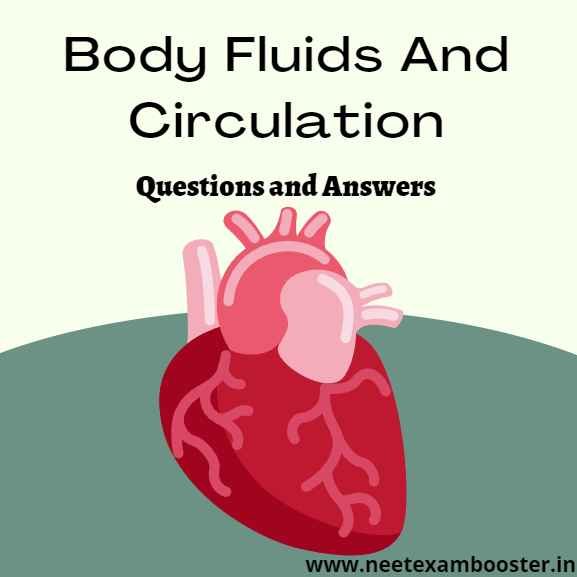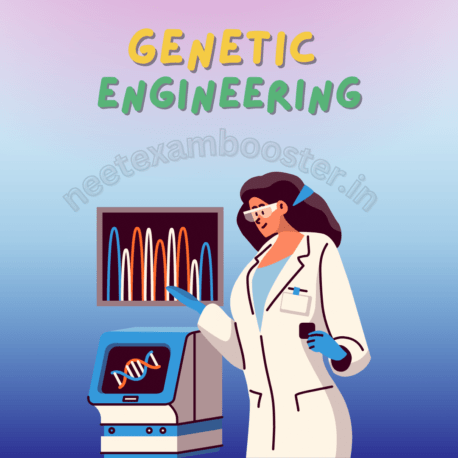Body Fluids And Circulation Class 11:- All living cells requires nutrients,O2 and other essential substances.The harmful substances and the waste materials which are produced,they have to removed continuously for the healthy or the proper functioning of the cells and the tissues.The complex organisms use special fluids inside their body for the transportation of essential nutrients and O2 .The most common body fluid used in the higher organism including human beings are called as Blood.Blood contains haemoglobin which is the carrier of Oxygen.The blood consists of three components such as RBC,WBC& Platelets.Higher organisms follows some mechanism of the blood circulation.

Body Fluids And Circulation Class 11 – Very Short Answer Type Questions
Q.1. What is the name of the blood component that is straw coloured liquid and viscous?
A.1. Plasma is straw coloured liquid and viscous.
Q.2. Fill in the blanks:
a) Serum is the plasma without _______ factors.
b) The Phagocytic cells are ______ and monocytes.
c) The Eosinophils are linked with the _______ reactions.
d) In the clotting, _____ ions plays very important role.
e) The heartbeat in an ECG, one can determine rate by counting number of ________.
A.2.
a) Clotting factor.
b) Neutrophils.
c) Allergic reaction
d) Calcium ions
e) The QRS complex.
Q.3. Which is the vascular connection between digestive tract and liver?
A.3. The hepatic portal system.
Q.4.Write the name of following disorders related to blood circulation.
a) The acute chest pain is due to the failure of oxygen supply to heart muscles
b)The increased systolic pressure is known as…
A.4.
a) Angina pectoris is the chest pain.
b) Hypertension – High blood pressure is to the increased systolic pressure.
Q.5. Writ the name of the coronary artery disease which is caused as a result of narrowing of the lumen of arteries.
A.5. Atherosclerosis is the coronary artery disease.
Body Fluids And Circulation Class 11 Quiz
Q.6. What is the result if the blood does not coagulate?
A.6. The blood coagulates or clots whenever there is an injury or trauma on any part of our body. The coagulation limits unnecessary blood loss from body. The absence of coagulation can cause huge blood loss and can be fatal.
Q.7. Write the role of time gap in passage of action potential from sino-atrial node to ventricle?
A.7. Time gap allows the ventricles to relax. Therefore, the ventricular pressure falls down, leading to closing of semilunar valves, and restricts or not allow backflow of blood into ventricles.
Q.8. Write the most common symptoms observed in people who are infected with Dengue fever?
A.8. Following are the symptoms observed in people who are infected with dengue fever.
- High fever
- Headache and body pain
- muscle and joint pains
- The significant increase in platelets counts in our body
Q.9. Define cardiac cycle.
A.9.Cardiac cycle is associated with complete heartbeat from its production to the commencement of next heartbeat. Cardiac cycle consists of the systole, and the intervening pause.
Q.10. Define ECG.
A.10.The Electrocardiogram or ECG is a test used to measure or to detect electrical activity of our heartbeat.
Body Fluids And Circulation Class 11 – Short Answer Type Questions
Q.1. Why are the walls of ventricles thicker than atria?Write the reason.
A.1. The Atria have thicker walls as ventricles to pump blood into various organs.
Q.2. Write the differences between the following questions:
- The Lymph and blood
- The Eosinophils and Basophils
- The Bicuspid valve and tricuspid valve
A.2.
Blood and Lymph
| Blood | Lymph |
| Blood is a connective tissue which consists of leucocytes, erythrocytes, and platelets in plasma, a fluid, flows in blood vessels | Lymph is a connective tissue which has WBC but no RBC in the plasma. It is flow in the lymphatic system. |
Basophils and Eosinophils
| Basophils | Eosinophils |
| Basophils having 3 lobular nucleus with the little quantity of coarse granules, which takes basic stain. Basophils are present in blood in the range of 0-1% | Eosinophils having a bilobed nucleus with granules in cytoplasm, which take acidic stains.It is present in blood in the range of 1-6% |
Tricuspid and bicuspid valve
| Tricuspid valve | Bicuspid valve |
| Tricuspid valve separates the right atria from the right ventricle. It has 3 flaps and it is also called as right atrioventricular valve. | Bicuspid valve separates left atrium from left ventricle. It has 2 flaps and it is also called as the mitral valve |
Q.3. Answer the questions below:
a) Write the name of the site where RBCs are formed.
b) Which part of the heart initiates and maintains the rhythmic activity?
c) Why the heart of crocodiles is different among all the reptilians?
A.3. a) Bone marrow is the site where RBC’s are formed.
b) In Sinoatrial node the heart initiates and maintain the rhythmic activity.
c)The reptiles are characterized by having 3 chambered heart except from the crocodile by having 4 chambered heart, due to the partial division of ventricle through a septum.
Q.4. Wrire the functional role of lymphatic system.
A.4. Lymphatic system carries blood from intestine to liver, before it is surrendered to t systemic . Following are the importance of lymphatic system :
- The blood from alimentary canal is rich in the glucose, amino acids, minerals and other nutrients. The excess amount of the glucose and fats are utilized by liver when the blood passes through during starvation.
- It Convert the toxic ammonia into urea which is later eliminated by the kidney
- Liver generates some proteins such as fibrinogen which is passed through circulation of blood.
Q5.For blood coagulation why are thrombocytes necessary?
A.5. The platelets or thrombocytes present in blood are formed inside the bone marrow and the life span of platelets are about a week. Whenever there is an injury blood oozes out from our body and platelets are released to produce a clotting factor called thromboplastin. With the presence of platelets and calcium ions, pro-thrombokinase gets activated.The blood clotting occurs with a series of reactions, plugging the injured blood vessel therefore preventing further blood loss.
Q.6.Write the functions of following one:
- Lymphatic System.
- Pulmonary vein.
- Lymphocytes.
A.6
- Lymphatic System– It transports the WBC to and from lymph nodes into the bones.
- Pulmonary vein– It transfers the oxygenated blood from lungs to the heart.
- Lymphocytes-It acts as a defence system of our body by defending against invading foreign substances.
Body Fluids And Circulation Class 11 Study Materials
Q.7.Write the symptoms of Hypertension.
A.7.Following are the common symptoms of hypertension are:
- Feeling Dizziness.
- Heart attack.
- Changes in visualisation.
- Breath shortness.
- Narrowing of the blood vessels and formation of plaques in the blood vessels.
Q.8.Give the causes of Anaemia.
A8.Following are the common symptoms of anaemia are:
- Pica an eating disorder.
- It causes Jaundice.
- Pale skin colour.
- Cramps in legs.
- Constipation occurs.
- Abdominal pain.
- It causes Severe joint pains .
- Shortness in breath.
- It causes headaches and Dizziness.
- Susceptibility to the infection
- Fatigue and Loss of energy causes by it.
Q.9.What is blood and lymph?
A.9. The blood and lymph are two essential fluids of human body. The blood is a fluid connective tissue which consists of plasma, blood cells and platelets.The lymph is a colourless fluid which circulates inside the lymphatic vessels that consist of lymph nodes and lymph vessels.
Q.10.Which are the two types of the circulatory system?
A.10.There are two types ofcirculatory system:
- Open Circulatory system– It is a type of circulatory system which is found only in insects. In this type of circulatory system of circulation of blood flows through parts of the body cavity, which is not in closed vessels
- Closed circulatory system-– It is a type of circulatory system which is found in all the vertebrates. In this type of system of circulation, blood flows through closed tubes called blood like vessels.
Body Fluids And Circulation Class 11 – Long Answer Type Questions
Q.1. Explain the Rh-incompatibility in humans.
A.1. The Rh antigen is seen on RBC surface of majority humans, the are known as Rh-positive individually and when these antigen is absent it is called as Rh-negative individually. Both individuals are the phenotypically normal individuals. Therefore, in the individuals, the problem enters during pregnancy or transfusion of blood. First blood transfusion from the Rh-positive blood to RI-T individual leads to the no harm as Rh-negative person acquires the antibodies or Rh factors in their own blood. At the time of second transfusion of blood, from the Rh-positive blood to Rh-negative individual, antibodies already formed attack to destruct RBC of the donor. In the time of pregnancy, if father’s blood is Rh-positive and mother’s blood is Rh-negative, blood of the fetus will be Rh-positive, which leads to serious issues. Rh antigens of fetus are not exposed to Rh-positive blood of tmother at the time of first pregnancy, as they are separated from the placenta. In Succeeding Rh-positive fetus, the anti-Rh factors from mother destruct RBCs of fetus as the blood of mother and the fetus mixes which causes hemolytic disease in the newborn baby(HDN) called as the erythroblastosis fetalis. It is prevented through the administration of anti-Rh antibodies to mother after the delivery of the first baby.
Q.2. Describe the events in the cardiac cycle. Explain what is ‘double circulation’?
A.2.Cardiac cycle makes for one heartbeat that is when one complete cycle of the relaxation and the contraction occurrs in the cardiac muscles, where one heartbeat constitutes for the contraction(systole) and the relaxation(diastole) of atria and ventricles. Following are the events:
- Atrial systole – Because of the wave of contraction, atria contracts, which is triggered by the sino-atrial node. And when the bicuspid and the tricuspid valve are open,blood is forced into the ventricles.
- Beginning of the ventricular systole – Wave of the contraction triggered by AV node causes the contraction of ventricles which leads to the bicuspid and tricuspid valve to close and therefore generates the first heartbeat sound that is– “lub”
- Complete Ventricular Systole – After ventricles contract,the blood flows into pulmonary trunk and the aorta because of the opening of semilunar valves.
- Beginning of the ventricular diastole – Ventricles relax while semilunar valves remain closed, that causes the second heart sound that is – dub.
- Complete ventricular diastole – Fall in the pressure of ventricles causes the opening of bicuspid and the tricuspid valve and therefore the blood flows from the atria to the ventricles. The blood does not flow in backward direction because of the contraction of heart as pressure inside relaxed ventricles is lesser in comparison to atria and the veins.
Double circulation – The two distinct pathways are present in the birds and the mammals. The left and right atria receives the oxygenated and the deoxygenated blood respectively which passed on the ventricles of same sides. Then ventricles pump it out of heart without mixing it up.
Q.3. Describe:
a) Hypertension
b) Coronary Artery Disease
A.3. a) Hypertension – It is high blood pressure disease which is the most commonly occurrs that affects the heart, blood vessels, brain, kidney an eyes. The normal blood pressure is about – 120/80. If this goes beyond 140mHg and 90 mm Hg, it is called as high blood pressure or hypertension. Following are the causes:
- The coronary heart vessels get blocked
- Smoking tobacco increases the process of heart rate.
b) Coronary Artery Disease (CAD) – This is arises due to deposition of fatty substances on the walls ofarteries that causes atherosclerotic plaques. Which leads to the lumen of artery to diminish thereby blocking flow of blood, that can sometimes block arteries completely leading to a heart attack.
Click here to join our telegram channel for more important questions like Body Fluids And Circulation Class 11.




















Pingback: NCERT Mathematics Class 12 PDF Free Download For NEET And JEE - NEET EXAM BOOSTER